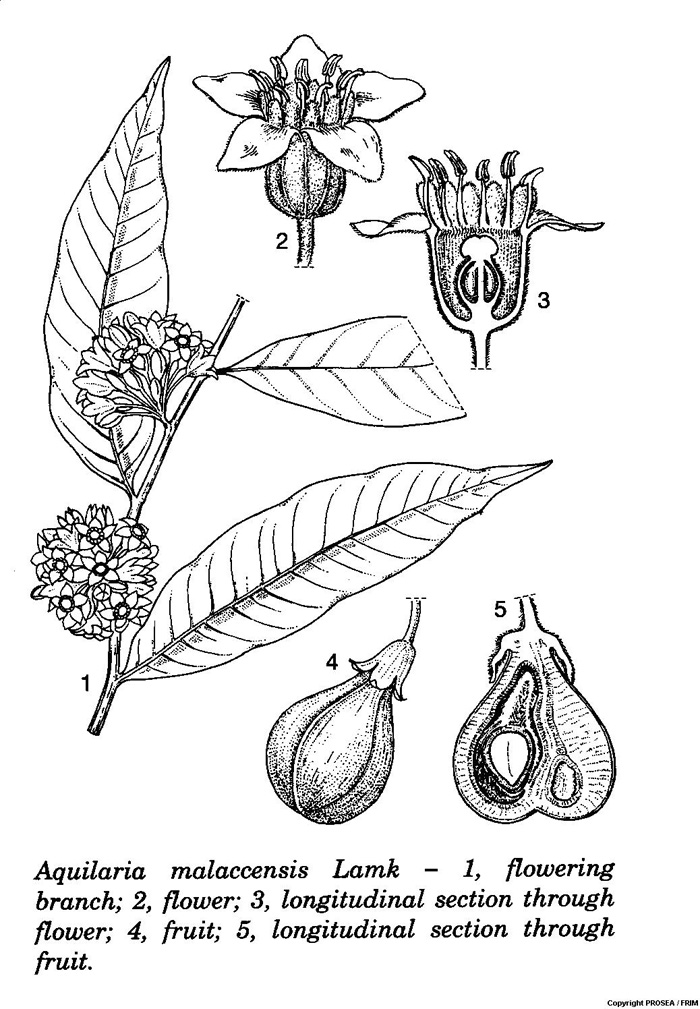Aquilaria malaccensis Lamk
Family
Thymelaeaceae
Synonyms
Aquilaria agallocha Roxb., Agallochum malaccense (Lamk) Kuntze, Aquilariella malaccensis (Lamk) v. Tieghem
Vernacular Names
| Malaysia | Gaharu, tengkaras, karas |
| English | Agar wood, malayan aloeswood, malayan eaglewood |
| Indonesia | Gaharu, kikaras (Sundanese), mengkaras (Sumatra) |
| Burma (Myanmar) | Agar |
| Vietnam | Tr[aaf]m h[uw] [ow]ng |
| French | Bois d’aigle, calambac, calambour |
Geographical Distributions
A. malaccensis occurs from north-eastern India (Bengal, Assam) through Burma (Myanmar) (Tenasserim) to Peninsular Malaysia, Sumatra, Bangka, Borneo and the Philippines (Luzon).
Description
This is a tree that reach up to 20(-40) m tall, with its bole up to 60 cm in diametre, usually straight but sometimes fluted. Buttresses are up to 2 m high. The bark is smooth and whitish. The branchlets are slender, pale brown, covered with soft short hairs or nearly devoid of hairs.
The leaves are simple, arranged alternate and supported by 4-6 mm long stalk. The blade is elliptical-oblong to oblong-lance-shaped between 7.5-12 cm x 2.5-5.5 cm. It is papery to nearly leathery texture, hairless but sometimes covered by soft short hairs and nearly devoid of hairs beneath. It’s shiny on both surfaces. Base is acute, attenuate or obtuse while apex is acuminate with acumen up to 2 cm long with rather irregular veins in 12-16 pairs. The veins are often branched, elevated and distinct beneath, curving upward to the margin, plane or obscure on the top surface.
Inflorescence is terminal, arising from axils or supra-arising from axils, sometimes from two nodes umbel, usually branched into 2-3 umbels, each with about 10 flowers supported by 5-15 mm long stalk. The 3-6 mm long pedicel is slender. The flowers are 5-merous, bell-shaped, 5-6 mm long, green or dirty yellow with scattered soft short hairs on its outside. The floral tube is nearly hairless on the inside, distinctly 10-ribbed and persistent in fruit. The 5 sepal lobes are egg-shaped-oblong, 2-3 mm long, almost as long as the tube. It is abruptly bent and lined with densely soft short hairs within. The 10 petal-like appendages are inserted at the throat of the tube, oblong or slightly egg-shaped-oblong, about 1 mm long. It is slightly incurved and dense with long soft hairs. There are ten 1.2-2 mm long filamentous stamens emerging from the throat of the tube.The anthers are linear and obtuse with the pistil included. The 1-1.5 mm long ovary is ovoid, 2-celled with dense soft short hairs. The pistil style is obscure with the headed stigma.
The fruit is a dorsal suture capsule, reverse egg-shaped solid object or reverse egg-shaped solid object-cylindrical that is 3-4 cm x 2.5 cm. It is usually compressed and covered with soft short hairs or nearly devoid of hair. Its base is wedge-shaped while the apex is rounded. The wall of ripened ovary is woody.
The 10 mm x 6 mm egg-shaped seed includes a 4 mm long beak dense with red hair. It bears an appendage that is as long as the seed, twisted from the base, tail-like and covered with soft short hairs.
Seedling germinates above ground.
Ecology / Cultivation
A. malaccensis is commonly found in primary and secondary forest, mainly in plains but also on hillsides and ridges up to 750 m altitude. It is scattered, in Peninsular Malaysia and northeastern India at a density of about 2.5 trees/ha. In northeastern India it occurs up to 1000 m altitude, but grows best in undulating terrain from 200-700 m. It thrives with an annual rainfall of 1500-6500 mm, a mean annual maximum temperature of 22-28°C and a mean annual minimum temperature of 14-21°C. It is found in wet-evergreen and evergreen forest and more rarely in semi-evergreen forest. A. malaccensis prefers heavy soils developed from gneiss and other metamorphic rocks, but it also grows well on sandy loams developed from sandstone.
Line Drawing / Photograph
Read More
1) Cultivation
References
-
Plant Resources of South-East Asia No 19. 1998.



